I should remind myself not to listen to the media (even the public broadcaster) when…
Australia – a very tepid labour market
The Australian Bureau of Statistics (ABS) published the Labour Force data for September 2011. It shows that a labour market that has arrested the decline evident in the previous two months but is barely keeping pace with underlying population growth and shedding working hours. The data is not bad but it is certainly not good and points to a weak economy overall. The best I can say about today’s data release is that the labour market is now not accelerating in reverse gear. How long that remains is anyone’s guess in these uncertain times where governments have largely abandoned any plans to provide fiscal support to help the economies grow. Overall, the Australian labour market is very tepid at present with a downward bias.
But first a digression – to put today’s data into some perspective. The British Office of National Statistics published the latest UK Labour Force data for October 2011 yesterday (October 12, 2011) which demonstrates how quickly the UK is going backwards courtesy of the damage being done by the British government’s austerity policy.
On the British labour force outcome, the UK Guardian article (October 12, 2011) – UK jobless at 17-year high deepens fears of slide into recession – said:
Mass public sector redundancies and a collapse of business confidence have pushed UK unemployment to its highest for 17 years, underlining fears of a slide to recession.
When will the British government acknowledge that their strategy has failed already and is impoverishing increasing numbers of British citizens?
The Prime Minister in response to questions about the data said:
I accept we’ve got to do more to get our economy moving, to get jobs for our people, but we mustn’t abandon the plan that has given us record low interest rates.
Which tells you that he has no conception of what determines interest rates. His priorities are also very strange (even if he actually holds the erroneous belief that he is trading of jobs for interest rates).
The Bank of England sets the interest rates and can control the rates at all maturities if it so chooses. All the British government is achieving in doing is directly shedding jobs and undermining the confidence of firms and consumers which will ensure there will not be a private sector spending comeback any time soon.
The other news from the UK yesterday was that the hoped for recovery in manufacturing has evaporated. The UK Guardian article (October 12, 2011) – The engine of growth has shrunk – reported that:
The plan was fairly plain, if not straightforward. With UK consumers and the public sector feeling pressure from so many sides, the manufacturing sector, and exports in particular, were supposed to become the engine of growth … Official data on Tuesday showed manufacturing output fell 0.3% in August and economists see little sign in business surveys that things will pick up soon. And rather than getting bigger the manufacturing sector is now smaller than ever.
The Guardian editorial (October 12, 2011) Rising unemployment: do something – quoted President Roosevelt, who when faced with rising unemployment said:
Do something. If it works, do more of it. If it doesn’t, do something else.
In labelling the UK job figures “predictable and predicted” the editorial said that “Britain’s unemployed deserve the same spirit of urgent improvisation today”.
Once again a victory for the hollow idealogues who think private markets will resolve the crisis. It is definitely time to “do something else”. And the British government could start by announcing large-scale public employment plans and abandoning their obsession with the budget deficit which they cannot control anyway and should never be a target of policy.
Which brings me to today’s ABS Labour Force data.
The summary ABS Labour Force (seasonally adjusted) estimates for September 2011 are:
- Employment increased 20,400 (0.2 per cent) with full-time employment increasing by 10,800 and part-time employment increasing by 8,600. This arrests the fall in full-time employment over the last two previous months
- Unemployment decreased by 3,800 (0.6 per cent) after rising last month by 18,400 (3.0 per cent). It is now at to 634,200.
- The official unemployment rate decreased to 5.2 per cent down from 5.3 per cent last month.
- The participation rate remained constant at 65.6 per cent.
- Aggregate monthly hours worked decreased 9.4 million hours (0.6 per cent).
- The quarterly labour underutilisation estimates were last published in August and showed that the ABS broad labour underutilisation rate hase risen over the last three months to 12.3 per cent (up from 12.2 per cent). This is due to the continued collapse in full-time work over the last few months.
The ABC News response – Unemployment rate edges lower – said that:
The number of jobs created during the month was more than double what was expected.
They could have said that while the bank economists once again were 100 per cent wrong the number of jobs (net) created was still a very weak result. The impression the ABC coverage gives to readers is that by fooling the bank economists (“double what was expected”) things are booming.
I thought the comment made by the Prime Minister Julia Gillard who “welcomed the figures, saying they were no accident” was appalling. The ABC reported her as saying:
It’s not a matter of autopilot; it takes careful and continued policy work and reform … It is no accident that our economy today is a resilient economy.
The Federal government has done very little for a year or so to support employment growth. That is why the economy has lost jobs over the last 12 months (see analysis later).
Further, as you will learn – the teenage labour market continues to deteriorate – and I would have expected the PM to express major concern about that and be interrogated by the journalists as to why her government is denying our future workers the chance to work and gain experience … and … what she was doing about it. There is a policy vacuum in this area.
No wonder her political rating is so low – and basically, terminal.
The more sensible commentary came from one of the bank economists:
Today’s data is not enough to offset the weakening that we’ve seen in employment growth over the last six months … So whilst it is a welcome reprieve, it doesn’t change the story that the labour force over the last six months has still weakened considerably from where we were six months ago.
The Sydney Morning Herald report carried the headline – Surprise jump in jobs .
Once again I would cease to use the word “surprise” when it comes to expectations provided to journalists by bank economists. They are continually wrong in both directions.
The SMH article also used loaded terms like “the jobs surge” to describe the very modest employment gains. The rest of the article related vacuous assessments by the bank economists about whether the RBA would increase interest rates next month.
We had the stunning revelation provided to us that “it was more likely for the RBA to lift rates eventually”.
Employment growing but tepid to say the least
The September data shows that employment increased by 20,400 (net) (0.2 per cent). There have been considerable fluctuations in the full-time/part-time performance and regular crossings of the zero growth line over the last year. Since December 2010, employment has declined 5 out of the 9 months, didn’t grow at all for another month, and average growth has been a miserly 0.1 per cent. So for the year to date we are effectively in a jobless growth environment.
Full-time employment expanded by 10,800 after contracting in the previous two months. This month’s expansion fails to match the lost jobs over the last three months.
Trend employment growth was zero in the last month and has been subdued since dropping sharply around November 2010 as the fiscal stimulus was withdrawn.
The following graph shows the month by month growth in full-time (blue columns), part-time (grey columns) and total employment (green line) for the 12 months to September 2011 using seasonally adjusted data. It is clear that the picture has been mixed over the last 12 months with employment growth averaging 0.1 per cent per month (full-time 0.2 per cent; part-time 0.0 per cent).
While full-time and part-time employment growth are fluctuating around the zero line, total employment growth is still well below the growth that was boosted by the fiscal-stimulus in the middle of 2010.

To put the recent data in perspective, the following graph shows the movement in the labour force and total employment since the low-point unemployment rate month in the last cycle (February 2008) to September 2011. The two series are indexed to 100 at that month. The green line (right-axis) is the gap (plotted against the right-axis) between the two aggregates and measures the change in the unemployment rate since the low-point of the last cycle (when it stood at 4 per cent).
You can see that even though the labour force is slowing (mainly due to a fall in working age population due to lower in-migration rates), the divergence between it and employment growth has been widening over the last several months, although in September there was small correction. The overall result is that the Gap (unemployment) has risen significantly in recent months.
The Gap series gives you a good impression of the asymmetry in unemployment rate responses even when the economy experiences a mild downturn (such as the case in Australia). The unemployment rate jumps quickly but declines slowly.
It also highlights the fact that the recovery is still not strong enough to bring the unemployment rate back down to its pre-crisis low. You can see clearly that the unemployment rate fell in late 2009 and then has hovered at the same level for some months before rising again over the last two months.
The Australian labour market continues to be stuck in a period of sluggish growth and fluctuating participation rates.
Teenage labour market – appalling and getting worse
The teenage labour market has continued to deteriorate in September from an already parlous starting point. The appears to be no policy awareness with the government and the media continually trying to convince us that the economy is close to full employment.
The following data shows that the teenage labour market is in an appalling state. In September 2011, teenagers endured further losses in both full-time and part-time employment. Teenage males “enjoyed” modest gains in part-time work while teenage females saw a tiny rise in full-time work.
The following graph shows the distribution of net employment creation in the last month by full-time/part-time status and age/gender category (15-19 year olds and the rest).
However, while that result is better than that experienced in the non-teenager segment of the labour market, if you take a longer view you see how poor the situation is.
Over the last twelve months teenagers have lost 4.8 thousand (net) jobs while the rest of the labour force has gained 120.4 thousand jobs (net). The 15-19 year olds lost 24.9 thousand full time jobs in the same period while gaining 20.1 thousand part-time jobs. In other words, the sparse job opportunities available to them are in the form of casualised, low-paid, insecure jobs that will not develop skills.
The following graph shows the change in aggregates over the last 12 months. Australian teenagers are going backwards which is a trend common around the world at present.
To further emphasise the plight of our teenagers I compiled the following graph that extends the time period from the February 2008, which was the month when the unemployment rate was at its low point in the last cycle, to the present month (September 2011). So it includes the period of downturn and then the “recovery” period. Note the change in vertical scale compared to the previous two graphs. That tells you something!
The results are stunning and represent a major policy failure. Since February 2008, there have been 653.5 thousand (net) jobs added to the Australian economy but teenagers have lost a staggering 67.1 thousand jobs (net) over the same period. It is even more stark when you consider that 75.6 thousand full-time teenager jobs have been lost in net terms while only 8.4 thousand (net) part-time jobs have been added.
Further, around 52 per cent of the total (net) jobs added since February 2008 have been part-time.
There is nothing good that you can say about any of that. It makes a mockery of those (like the bank economists and our politicians) who claim we are close to full employment. An economy that excludes its active teenagers from any employment growth at all is not one that is using its existing capacity to its potential.
The longer-run consequences of this teenage “lock out” will be very damaging.
In the May 2011 quarter broad labour underutilisation data released last month by the ABS, the underemployment rate for 15-24 year olds was 13.1 per cent (up from 12.9 per cent in the February quarter). Total labour underutilisation for 15-24 year olds was 24.2 per cent (only marginally below the 24.6 per cent in February).
In the August 2011 quarter (the most recent broad labour underutilisation data), the underemployment rate for 15-24 year olds was 13.5 per cent. Total labour underutilisation for 15-24 year olds was 24.9 per cent.
This is an economy that the Treasurer says is booming and in need of fiscal austerity but in which 25 per cent of our 15-24 year olds (who are seeking work) are idle (sum of unemployment and underemployment).
It is clear that the Australian labour market continues to fail our 15-19 year olds. At a time when we keep emphasising the future challenges facing the nation in terms of an ageing population and rising dependency ratios the economy still fails to provide enough work (and on-the-job experience) for our teenagers who are our future workforce.
Unemployment
The unemployment rate fell by 0.1 percentage points to 5.2 per cent in September after rising sharply by 0.2 percentage points in August to 5.3 per cent. The renewed though weak employment growth was suffient to outstrip the very weak labour force growth at present and so unemployment fell modestly.
With participation rates constant all the labour force growth is being driven by underlying growth in the working age population (above 15 year olds) even though that growth is slowing (due to a decline in in-migration rates).
Overall, the labour market still has significant excess capacity available in most areas and what growth there is is not making any major inroads into the idle pools of labour.
The following graph updates my 3-recessions graph which depicts how quickly the unemployment rose in Australia during each of the three major recessions in recent history: 1982, 1991 and 2009 (the latter to capture the 2008-2010 episode). The unemployment rate was indexed at 100 at its lowest rate before the recession in each case (August 1981; November 1989; February 2008, respectively) and then indexed to that base for each of the months as the recession unfolded.
I have plotted the 3 episodes for 45 months after the low-point unemployment rate was reached (although the current episode has only endured for 44 months). For 1991, the end-point shown is the peak unemployment which was achieved some 38 months after the downturn began although the recovery was painfully slow. While the 1982 recession was severe the economy and the labour market was recovering by the 26th month. The pace of recovery for the 1982 once it began was faster than the recovery in the current period.
It is significant that the current situation while significantly less severe than the previous recessions is dragging on which is a reflection of the lack of private spending growth and declining public spending growth.
The graph provides a graphical depiction of the speed at which the recession unfolded (which tells you something about each episode) and the length of time that the labour market deteriorated (expressed in terms of the unemployment rate).
From the start of the downturn to the 44-month point (to September 2011), the official unemployment rate has risen from a base index value of 100 to a value 130 – peaking at 145 after 21 months. At the same stage in 1991 the rise was 191 (and struggling to decline) and in 1982 – 159 (and falling overall with monthly variations).
Note that these are index numbers and only tell us about the speed of decay rather than levels of unemployment. Clearly the 5.3 per cent at this stage of the downturn is lower that the unemployment rate was in the previous recessions at a comparable point in the cycle although we have to consider the broader measures of labour underutilisation (which include underemployment) before we draw any clear conclusions.
The notable aspect of the current situation is that the recovery has more or less stalled.
Aggregate participation rate remains constant
The participation rate remained unchanged in September but has fallen over the last 6 months by 0.2 per cent.
Hours worked decline in September
Total monthly hours worked fell in September by 9.4 million hours (or 0.6 per cent) wiping out the gains made over the previous two months. After the initial fiscal-driven recovery from the recession, the trend is now flat.
The following graph shows the trend and seasonally adjusted aggregate hours worked indexed to 100 at the peak in February 2008 (which was the low-point unemployment rate in the previous cycle). The rising trend which marked the early recovery courtesy of the fiscal stimulus has now flattened.
The next graph shows the monthly growth (in per cent) over the last 12 months. The green linear line is a simple regression trend and it is suggesting monthly growth rates are struggling.
Once again the data doesn’t support the notion of a fully employed labour market that is bursting against the inflation barrier.
Conclusion
Yes, the situation is better than in the United Kingdom. But then that wouldn’t be saying much at all.
The August Labour Force data shows that the Australian economic recovery is is a very flat state – with months of contraction interspersed with very tepid growth (as in September).
We always have to be careful interpreting month to month movements given the way the Labour Force Survey is constructed and implemented but there has now been enough data over the last several months to tell us that my assessment in the previous paragraph is sound.
Employment growth over the last twelve months has been negative and unemployment has risen again at a time when the economy should have been building on the early fiscal-led recovery. Unemployment is not that far from the peak of the downturn in 2008.
With hours of work declining in September it is also likely that underemployment has also risen. We get the next data for that in November 2011. The most recent estimates (August 2011) show that the total labour underutilisation rate (the broad measure – the sum of unemployment and underemployment) has risen to 12.3 per cent.
There is still a lot of slack left to be mopped up and the teenage employment problem is manifest and should be a policy priority.
That is enough for today!
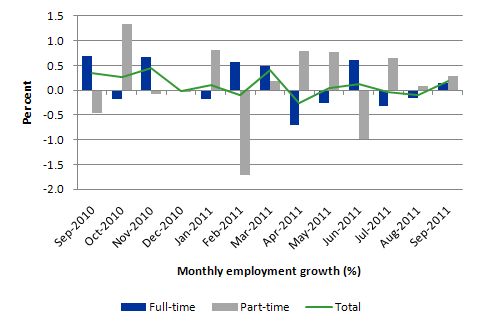
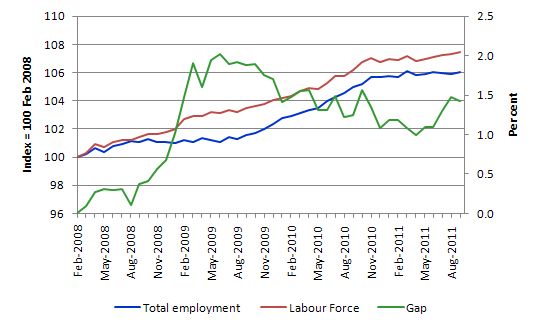
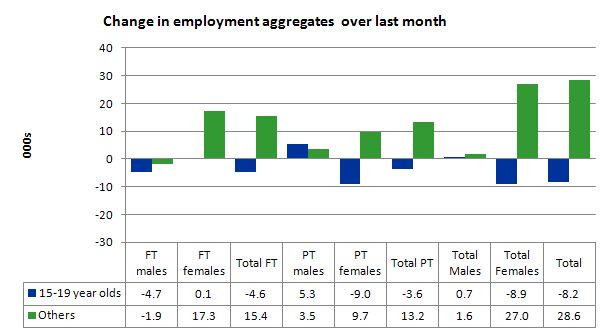

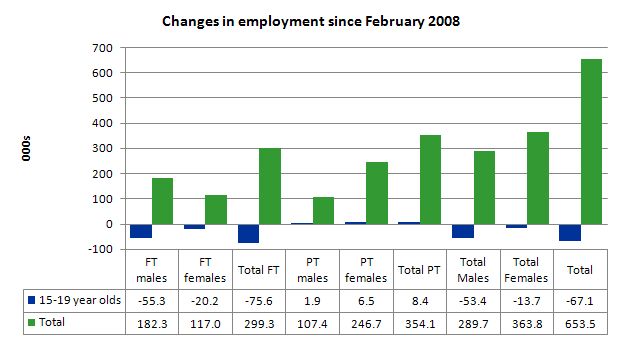
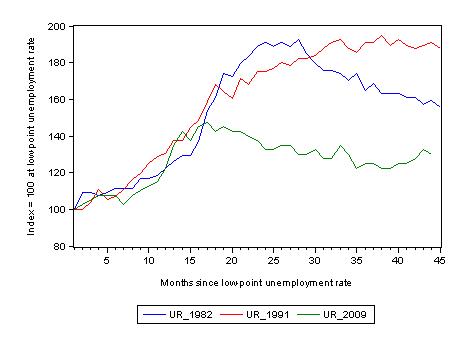

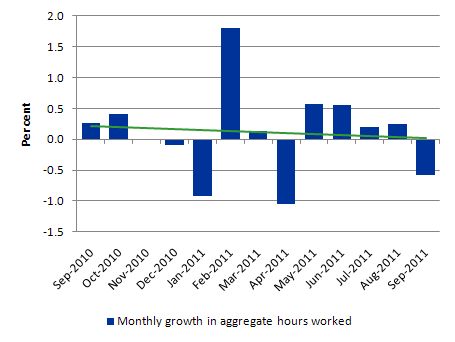
“And the British government could start by announcing large-scale public employment plans and abandoning their obsession with the budget deficit which they cannot control anyway and should never be a target of policy.”
There is one small problem with that idea in the UK under our current arrangements.
The European Union rules require ‘freedom of movement’ and the European Commission has already warned the UK that the ‘right to reside’ test is contrary to the treaty provisions.
So another argument against the Job Guarantee I’m coming up against is that the UK would become the destination for all of Europe’s unemployed.
Which brings me to the question. Is tight Border Control a requirement before you can introduce a Job Guarantee.
It’s a sad day isn’t it when the surprise in jobs is a 20k result.
“The 15-19 year olds lost 24.9 thousand full time jobs in the same period while gaining 20.1 thousand part-time jobs. ” ……. this is a bit a concern isn’t it? Not just the for this cohort, or the more macro and intergenrational idea of dependency ratios that mean we’ll have an under-skilled problem in the future, but the jobs they’re being given are essentially service jobs. Not traineeships or apprenticeships, but jobs that, if we are to face (an almost inevitable) recession, will evaporate. I was wondering about the speed of the current rise in the unemployment rate (not out of control at this stage), but I can see where/how it might occur.
Quickie on hours (for the dummy)….how is it that hours kept performing ‘alright’ through a period of poor employment (and full-time) growth, and now drops reasonably sharply when both full-time and part-time increase?
By the way, do you have any specific thoughts on Q3 inflation now that the base/basket has been changed?